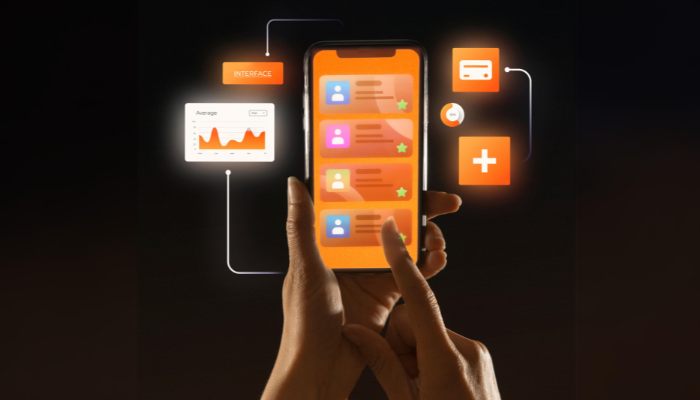“The best technology brings people together.” That’s what Matt Mullenweg said, and it perfectly describes Progressive Web Apps (PWAs) on iOS. These apps are like a bridge between websites and mobile apps, making things easier for everyone. But their journey on iOS hasn’t been smooth sailing.
With the recent iOS 16.4 update, PWAs can now send push notifications, which is a big win! However, challenges remain, such as inconsistent performance and limited access to device features.
In this blog, we’ll dive deeper into the current state and limitations of Progressive Web Apps on iOS. You’ll learn about the obstacles they face and what the future might hold.
Let’s go!
Progressive Web Apps on iOS: A Growing Trend
Progressive Web Apps (PWAs) have been making waves in the world of web development, offering a seamless user experience that blurs the lines between websites and mobile apps. However, Apple’s initial reluctance to embrace PWAs has created a unique landscape for these innovative applications on iOS devices.
What are PWAs?
PWAs are web applications that leverage modern web technologies to deliver app-like experiences. They offer features such as offline functionality, push notifications, and home screen shortcuts, making them feel more native to the device.
Apple’s Changing Stance
At first, Apple wasn’t fully on board with progressive web apps on iOS. But guess what? Things have changed! With the launch of iOS 14, Apple introduced some cool upgrades for Do progressive web apps work on IOS. Now, you can add web app icons right to your home screen, making it super easy to access your favorite apps. Plus, the performance has improved, which means a smoother experience for users.
This shift has opened up exciting opportunities for developers to dive into the world of Iphone progressive web app. Now’s the perfect time to explore what these apps can do and how they can make your life easier and more enjoyable!
Benefits of PWAs on iOS
- Enhanced User Experience: PWAs offer a faster, more responsive experience compared to traditional websites, making them ideal for users on the go.
- Offline Functionality: Users can access content and features even when they’re not connected to the internet, providing a seamless experience.
- Push Notifications: PWAs can send real-time notifications, keeping users engaged and informed.
- Home Screen Shortcuts: Users can add PWAs to their home screen for quick and easy access.
- Reduced Development Costs: PWAs can be developed using web technologies, potentially reducing development costs compared to native apps.
Popular Examples of PWAs on iOS
- Twitter: Twitter’s PWA offers a streamlined experience for users who prefer to access the platform through their web browser.
- Pinterest: Pinterest’s PWA provides a seamless way to browse and discover visual content.
- Starbucks: Starbucks’ PWA allows users to order and pay for drinks ahead of time, making the process more convenient.
- Forbes: Forbes’ PWA delivers breaking news and articles in a fast and efficient manner.
The Evolving Landscape of PWAs on iOS
The world of Progressive Web Apps (PWAs) is evolving, especially on iOS. Recent advancements have made these applications more accessible and functional, bringing them to the forefront of progressive web apps on iOS. With Apple’s latest updates, PWAs are now more powerful than ever.
Here’s a closer look at the current status and exciting features that make PWAs stand out.
Key Updates and Features
iOS 16.4 Push Notifications
One of the coolest updates in iOS 16.4 is the addition of push notification support for progressive web apps on iOS. This means developers can send real-time alerts and updates directly to you, even when the app isn’t open. Imagine getting important notifications from progressive web apps on iOS without having to check the app all the time—it really makes life easier!
Improved Web App Manifests
The web app manifest, a key part of PWAs, has been improved to give developers more control over how apps show up on your home screen. Now, they can customize icons, display modes, and other details, making your experience more visually appealing and user-friendly.
Enhanced Service Worker Capabilities
Service workers, which help progressive web apps on iOS work offline and cache content, have also received some upgrades. This means your PWAs will load faster and provide a more reliable experience. Who doesn’t love a quicker, smoother app experience?
WebAssembly Integration
WebAssembly, a tool for building web applications, is now available on iOS. This lets developers create more complex and responsive PWAs. You’ll find more interactive experiences and features that keep you engaged and satisfied.
Background Synchronization
Now, progressive web apps on iOS can perform tasks in the background, even when you’re not actively using them. This is great for syncing data, updating content, or sending notifications without interruption.
Expanding PWA Capabilities
Besides push notifications and speed boosts, PWAs on iOS are gaining access to even more features and tools. This includes support for background tasks, camera and microphone access, and other functions that used to be exclusive to native apps. The possibilities are really opening up!
PWAs on iOS: The Roadblocks You Need to Know
Progressive web apps on iOS are becoming more popular, but if you’ve tried using them, you’ve probably run into a few roadblocks. Apple has been a bit slow to fully embrace PWAs, which means there are still a few things that don’t work as smoothly as they do with native apps.
Here’s a look at the top ten common challenges you’ll face with PWAs on iOS—and some practical ways to deal with them.
1. Manual Installation Process
Let’s face it—installing a PWA on iOS isn’t as easy as tapping “Get” in the App Store. You have to open Safari, tap “Share,” then hit “Add to Home Screen.” It’s not difficult, but it’s not exactly intuitive either, and some users may never figure it out.
How to fix it: Make it easier for users by adding clear instructions or even a friendly pop-up within the app itself. A quick guide with screenshots can do wonders to reduce confusion.
2. No App Store Listing
Your PWA won’t show up in the App Store. That means you can’t rely on the exposure native apps get just by being listed. Users have to find your app some other way.
How to fix it: Promote your PWA like it’s your best-kept secret. Use social media, SEO, and direct links on your website to get the word out. If people can’t find it in the App Store, make it easy to find elsewhere.
3. Limited Access to Native Features
Here’s the catch: PWAs can’t use everything iOS offers. Things like Face ID, certain camera functions, or Bluetooth are off-limits. This can be a dealbreaker if your app relies on those features.
How to fix it: Focus on what PWAs can do, like offline functionality, push notifications, and background sync. If native features are essential, you might need to consider a hybrid app that combines both PWA and native elements.
4. No Push Notifications on Older iOS
Good news: iOS 16.4 finally brought push notifications to PWAs. Bad news: If users are on older versions, they still won’t get them.
How to fix it: Encourage users to upgrade their iOS version. For those still stuck on older versions, you can keep them in the loop with in-app notifications or good old-fashioned email.
5. Spotty Offline Support
Apple progressive web app functionality should allow PWAs to work offline, right? Well, sort of. iOS sometimes restricts background processes, causing hiccups in offline use.
How to fix it: Make sure key parts of your app are fully functional without an internet connection. Let users know upfront what works offline and what requires a connection.
With a little creativity and smart planning, you can turn these challenges into opportunities to improve the user experience of your PWA on iOS.
6. Restricted Background Processes
PWAs often struggle with things like syncing data or refreshing content when you’re not using the app. This can be annoying, especially if you need real-time updates or constant connection.
How to fix it: Focus on making your PWA need fewer background tasks. Let users manually refresh content and give a heads-up when updates are ready. That way, everyone stays in the loop!
7. No Access to Cool Features Like ARKit and iMessage
On iOS, PWAs can’t use advanced features like ARKit for augmented reality or iMessage for enhanced messaging. That limits what you can offer, especially if your app is in gaming or communication.
How to fix it: If AR or messaging is a must, consider mixing a PWA with a native app. If not, focus on features PWAs are great at, like push notifications or geolocation.
8. Offline Functionality Isn’t Perfect
PWAs are supposed to work offline, but service worker limitations on iOS can make it tricky. Some content might not load, and updates could be slower.
How to fix it: Make sure your PWA works at least a bit offline. Tell users what features will work without the internet and when they’ll need to reconnect.
9. Impact on User Experience Due to Web App Manifest Restrictions
Using a progressive web app (PWA) on iOS can come with challenges, especially due to web app manifest restrictions. For example, iOS doesn’t allow custom splash screens or specific screen orientations. This can make your app feel less polished than native apps.
How to fix it: Make sure your app is user-friendly and visually appealing despite these limitations. Focus on intuitive designs that let users access key features easily.
10. Performance Limitations in Heavy-Resource Applications
PWAs can struggle with heavy-resource apps, like games or data-intensive tools, on iOS. Limited access to device hardware can slow down performance, which can frustrate users.
How to fix it: Consider combining your PWA with native features to enhance performance while maintaining the web app’s accessibility.
Future Outlook for Progressive Web Apps on iOS
Even though there are some limitations right now, the future of progressive web apps (PWAs) on iOS is looking very promising. With new technologies and Apple’s potential improvements, there are exciting things ahead.
Let’s break down what you can expect!
Expected Advancements with Emerging Technologies
One cool development is WebAssembly. This technology allows developers to use different programming languages to create apps, making progressive web apps on iOS even more powerful. Just imagine apps that run almost as smoothly as native ones! With faster and better browsers, you’ll likely experience a smoother and more enjoyable app experience.
Enhanced Apple Support
Apple is starting to show more support for progressive web apps. In the last year, they’ve rolled out updates to Safari that enhance how PWAs operate, such as better caching and service worker support.
This means that Apple truly cares about user experience, and we can look forward to even more enhancements that will make progressive web apps on iOS much more competitive with traditional apps.
Integration of Native Features
In the future, PWAs on iOS might gain access to more native features. This could help bridge the gap between web apps and native applications.
Imagine being able to use features like NFC and Bluetooth with your PWA! This would open up exciting new possibilities for developers and give you a richer, more integrated experience.
Increased Adoption
More businesses are realizing the benefits of progressive web apps on iOS, so we can expect to see more of them adopting PWAs.
As companies look for cost-effective solutions, developers will likely focus on making these apps better and more user-friendly. If you’re a business owner or developer, it’s a fantastic time to explore what PWAs can do for you!
Improved User Engagement Strategies
Another exciting part of the future is how PWAs can boost user engagement. With innovative tools and strategies, these apps can keep users coming back for more.
Just think about incorporating social sharing features and personalized experiences—this can make a significant difference in how you interact with an app. Personalization is key, and it can greatly improve user engagement and retention.
Cross-Platform Compatibility
Picture this: you have a consistent app experience, whether you’re using iOS, Android, or desktop. Future developments might make this possible for progressive web apps.
This means you can enjoy the same high-quality app experience, no matter what device you’re on. It’s a real game-changer for businesses that want to reach a wider audience without losing quality.
Focus on Security Enhancements
Security is crucial in app development, and progressive web apps on iOS are expected to raise their security standards. With growing concerns about data protection, we can anticipate that these apps will adopt better security features.
Enhanced security will not only protect you but also build trust, making ios progressive web app a reliable choice for sensitive applications like banking or healthcare.
How CODEWAVE Can Help You Conquer Progressive Web Apps on iOS
We understand the potential of progressive web apps (PWAs) on iOS, but navigating the limitations and keeping up with the latest advancements can be tricky. That’s where Codewave comes in! We’re a design thinking-led digital innovation company passionate about helping businesses unlock the power of PWAs.
We are your PWA crew – we’ll provide the expertise and resources to get your app running smoothly on iOS devices. Here’s how we can help:
- Angular Development: Our expertise in Angular development ensures that your PWA is not only fast but also scalable. We create applications that deliver smooth user experiences across all devices.
- Mobile App Development: We specialize in building mobile apps that feel native while benefiting from the flexibility of PWAs. This approach allows you to reach a wider audience without the heavy lifting of traditional app development.
- Flutter Development: With Flutter, we can craft visually appealing and high-performance applications. Our team leverages Flutter’s capabilities to create PWAs that shine on iOS, giving you an edge in the competitive landscape.
- React Native Development: By using React Native, we develop PWAs that offer a native-like experience, ensuring your users remain engaged and satisfied.
Let us help you transform your ideas into effective Progressive web app ios.
Conclusion
As we wrap up our exploration of progressive web apps on iOS, it’s clear that while challenges exist—like limited access to native features and inconsistent performance—there’s a bright future ahead. The potential of PWAs is immense, especially with ongoing advancements in technology and improved support from Apple.
“The only limit to our realization of tomorrow will be our doubts of today.”
— Franklin D. Roosevelt.
To make the most of progressive web apps on iOS, focus on creating a great user experience. Stay updated on the latest tech trends and keep an eye on Apple’s changes. These steps will help you enhance your PWA for better engagement and performance.
At Codewave, we love turning challenges into opportunities. If you’re ready to see what PWAs can do for your business, let’s chat! Visit Codewave to learn how we can build a powerful PWA that meets your needs.
Together, we can create an awesome digital presence! Also read: Advantages and Key Features of Progressive Web Apps: A Detailed Overview
Codewave is a UX first design thinking & digital transformation services company, designing & engineering innovative mobile apps, cloud, & edge solutions.







